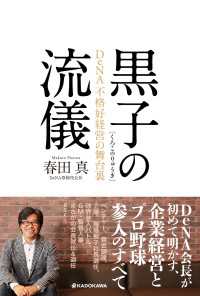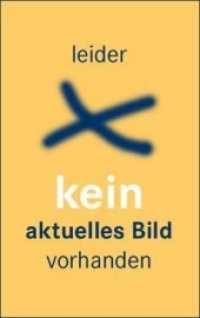- ホーム
- > 洋書
- > 英文書
- > Health / Fitness
Full Description
A fun introductory guide to yoga anatomy for new and experienced yoga teachers, practitioners, and enthusiasts
Knowledge of anatomy is a crucial part of every effective yoga practice, but the subject can be dry and difficult. Yoga Anatomy Made Simple provides a fun solution-it's a go-to guide to functional yoga anatomy, written for yoga practitioners looking to jump in and start applying key concepts to their work. Here, longtime yoga teacher Stuart Girling pairs his expertise with real-life examples and colorful, jaunty illustrations to create a book that serves as an easy-to-understand introduction and refresher course for yogis, teachers, and trainers.
Yoga Anatomy Made Simple provides simple explanations of key yoga-anatomy concepts, like patterns, variety, breath, and strength. The illustrations are diverse, inclusive, joyful, and fun-and mirror the author's own accessible, unpretentious approach to practical yoga anatomy. Concepts are demonstrated on different body parts, as well as the following posture groups:
* Forward bends
* Hip rotations
* Backbends
* Twists
* Postures involving the shoulders
* Inversions
* Arm balances
Girling ties everything together in a holistic framework with a playful touch on every page-one that embraces each student's lifestyle, environment, and life history. Yoga teachers will learn to elevate their ability to analyze yoga postures from a physical perspective, sequence more effectively, avoid unnecessary injury, and appreciate the importance of individuality within postural yoga.
Contents
Part I-Key Concepts
Chapter 1: Fundamentals of Yoga Postures; Making Shapes; Individuality; Gravity; Alignment; Fighting Own Restrictions; Balance
Chapter 2: Movement Basics; Range of Motion; Flexibility; Multi-segmental Movement; Moving in Patterns; Compression; Fundamental Movements; Relational Movement
Chapter 3: Muscles and Fascia; Neurophysiology; Open and Closed Kinetic Chains; Polyarticular Muscles; Strength; Variety
Opposing Muscles Restrict; Secondary Action of Muscles; Fascial Considerations
Chapter 4: Breath; Breath; Breath and Posture; Breath and Trauma
Chapter 5: Other Personal Considerations; Environmental influences; Lifestyle; Personal History; Psychology; Risk Factors
Part II-Body Bits
Chapter 6: Ankle and Foot; Construction of the Foot and Ankle; Muscles that Move the Foot and Ankle; Arches of the Foot; Foot Alignment; So How Do We Start Working on This?; Putting Things into Context
Chapter 7: Knee; Construction of the Knee Joint; Muscles that Move the Knee; Putting Things into Context
Chapter 8: Hip; Construction of the Hip Joint; Muscles that Move the Hip; Putting Things into Context
Chapter 9: Spine; Construction of the Spine; Muscles that Move the Spine; Putting Things into Context
Chapter 10: Sacroiliac Joint; Construction of the Sacroiliac Joint; Muscles that Move the Sacrum; Putting Things into Context
Chapter 11: Shoulder; Construction of the Shoulder Complex; Muscles that Move the Shoulder Complex; Putting Things into Context; A Bit About Moving the Head; Putting Things into Context
Chapter 12: Elbow and Wrist; Construction of the Elbow; Muscles that Move the Elbow; Putting Things into Context; Construction of the Wrist; Muscles that Move the Wrist; Putting Things into Context
Part III-Posture Groups
Chapter 13:Forward Bends
Chapter 14: Hip Rotations
Chapter 15: Backbends
Chapter 16: Twists
Chapter 17: Postures Involving the Shoulders
Chapter 18: Inversions
Chapter 19: Arm Balances
Appendix I: Anatomical Language and Movement Terminology
Appendix II: Stu's Simple Model of Infinite Complexity
Appendix III:Names of Poses/Postures (Asanas)







